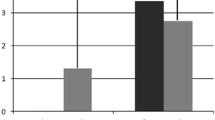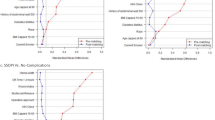Abstract
Background
An increasing proportion of ventral hernia patients are over age 65. These patients are frequently offered watchful waiting rather than surgical intervention due to their frail state or perioperative risk. However, many in this age group suffer from significant quality of life impacts that are not well understood.
Methods
We performed a retrospective cohort study using data from the Abdominal Core Health Quality Collaborative (ACHQC), including adults undergoing elective ventral hernia repair from 2013 to 2019. Median differences in Hernia-Related Quality of Life Survey (HerQLes) summary scores at baseline, 30-days, 6-months, and 1 year post operatively were compared in four age categories (18–40, 40–64, 65–75, 76 +) using multivariable regression. Secondary outcomes included major post-operative complications and mortality.
Results
Of 6681 patients meeting inclusion criteria, 13.5% were 18–40, 55.8% were 41–64, 25.2% were 65–75, and 5% were 76 + . Patients in the 65–75 age group and those over 76 had higher mean baseline HerQLes scores (51.7 and 60.8) compared to those in the 18–40 and 41–64 groups (45 and 43.3, p < 0.01). Patients 65–75 had smaller increases in HerQLes scores at 30 days (6.7) compared to patients in the younger age groups (11.7 for 18–40; 8.3 for 41–64) and the oldest age group (8.3, p < 0.01). However, patients in the older age groups had higher overall median 1 year HerQles Scores (66.7 for 65–75; 78.3 for 76 +) compared to patients in the 18–40 and 41–64 age groups (65 and 58.3, p < 0.01). On multivariable analysis, HerQLes scores at 30 days post-surgery were decreased for patients in the 41–64 (−3.14, CE −5.89, −0.04, p = 0.03) and 65–75 (−4.53; CE −7.65, −1.41, p < 0.01) groups compared to the youngest age group, while those over 76 had no effect.
Conclusion
Older adults undergoing ventral hernia repair demonstrate equal gains in hernia-related quality of life compared to younger patients and actually report higher quality of life scores at 30 days, 6 months and, 1 year post-surgery.



Similar content being viewed by others

References
Jennifer Ortman VV, Hogan H (2014) An aging nation: the oler population in the United States, population estimates and projections. Current population reports. 24–1145
Balla FM, Yheulon CG, Stetler JL, Patel AD, Lin E, Davis SS (2019) Ventral hernia repair outcomes predicted by a 5-item modified frailty index using NSQIP variables. Hernia 23(5):891–898
IT Collaboration (2011) Operation compared with watchful waiting in elderly male inguinal hernia patients: a review and data analysis. J Am Coll Surg 212(2):251–259 (e251-254)
O’Dwyer PJ, Norrie J, Alani A, Walker A, Duffy F, Horgan P (2006) Observation or operation for patients with an asymptomatic inguinal hernia: a randomized clinical trial. Ann Surg 244(2):167–173
Fitzgibbons RJ Jr, Giobbie-Hurder A, Gibbs JO et al (2006) Watchful waiting vs repair of inguinal hernia in minimally symptomatic men: a randomized clinical trial. JAMA 295(3):285–292
Turrentine FE, Wang H, Simpson VB, Jones RS (2006) Surgical risk factors, morbidity, and mortality in elderly patients. J Am Coll Surg 203(6):865–877
Kaafarani HM, Kaufman D, Reda D, Itani KM (2010) Predictors of surgical site infection in laparoscopic and open ventral incisional herniorrhaphy. J Surg Res 163(2):229–234
Gokcal F, Morrison S, Kudsi OY (2020) Robotic ventral hernia repair in octogenarians: perioperative and long-term outcomes. J Robot Surg 14(2):275–281
Neupane R, Fayezizadeh M, Majumder A, Novitsky YW (2017) Is old age a contraindication to elective ventral hernia repair? Surg Endosc 31(11):4425–4430
Poulose BK, Roll S, Murphy JW et al (2016) Design and implementation of the Americas hernia society quality collaborative (AHSQC): improving value in hernia care. Hernia 20(2):177–189
Krpata DM, Schmotzer BJ, Flocke S et al (2012) Design and initial implementation of HerQLes: a hernia-related quality-of-life survey to assess abdominal wall function. J Am Coll Surg 215(5):635–642
Blount AL, Craft RO, Harold KL (2009) Safety of laparoscopic ventral hernia repair in octogenarians. J Soc Laparoendosc Surg 13(3):323–326
Tessier DJ, Swain JM, Harold KL (2006) Safety of laparoscopic ventral hernia repair in older adults. Hernia 10(1):53–57
Ferrarese AG, Martino V, Enrico S et al (2013) Laparoscopic repair of wound defects in the elderly: our experience of 5 years. BMC Surg 13(Suppl 2):S23
Helgstrand F, Rosenberg J, Kehlet H, Bisgaard T (2013) Outcomes after emergency versus elective ventral hernia repair: a prospective nationwide study. World J Surg 37(10):2273–2279
Huerta S, Pham T, Foster S, Livingston EH, Dineen S (2014) Outcomes of emergent inguinal hernia repair in veteran octogenarians. Am Surg 80(5):479–483
Yong HH, Gibson SJ, Horne DJ, Helme RD (2001) Development of a pain attitudes questionnaire to assess stoicism and cautiousness for possible age differences. J Gerontol B 56(5):P279-284
Owei L, Swendiman RA, Kelz RR, Dempsey DT, Dumon KR (2017) Impact of body mass index on open ventral hernia repair: a retrospective review. Surgery 162(6):1320–1329
Regner JL, Mrdutt MM, Munoz-Maldonado Y (2015) Tailoring surgical approach for elective ventral hernia repair based on obesity and national surgical quality improvement program outcomes. Am J Surg 210(6):1024–1029 (discussion 1029–1030)
Wormer BA, Walters AL, Bradley JF 3rd et al (2013) Does ventral hernia defect length, width, or area predict postoperative quality of life? Answers from a prospective, international study. J Surg Res 184(1):169–177
Cheatham ML, Safcsak K, Llerena LE, Morrow CE Jr, Block EF (2004) Long-term physical, mental, and functional consequences of abdominal decompression. J Trauma 56(2):237–241 (discussion 241-232)
Goodney PP, Birkmeyer CM, Birkmeyer JD (2002) Short-term outcomes of laparoscopic and open ventral hernia repair: a meta-analysis. Arch Surg 137(10):1161–1165
Bingener J, Buck L, Richards M, Michalek J, Schwesinger W, Sirinek K (2007) Long-term outcomes in laparoscopic vs open ventral hernia repair. Arch Surg 142(6):562–567
Liang MK, Clapp M, Li LT, Berger RL, Hicks SC, Awad S (2013) Patient satisfaction, chronic pain, and functional status following laparoscopic ventral hernia repair. World J Surg 37(3):530–537
Eriksen JR, Poornoroozy P, Jorgensen LN, Jacobsen B, Friis-Andersen HU, Rosenberg J (2009) Pain, quality of life and recovery after laparoscopic ventral hernia repair. Hernia 13(1):13–21
Author information
Authors and Affiliations
Corresponding author
Ethics declarations
Disclosures
Dr. Courtney Collins, Savannah Renshaw, Anand Gupta, and Dr. Heena Santry do not have anything to disclose. Dr. Benjamin Poulose receives research support from Advanced Medical Solution, BD-Interventional and salary support from the Abdominal Core Health Quality Collaborative (ACHQC).
Additional information
Publisher's Note
Springer Nature remains neutral with regard to jurisdictional claims in published maps and institutional affiliations.
Rights and permissions
About this article
Cite this article
Collins, C.E., Renshaw, S., Gupta, A. et al. Elective ventral hernia repair provides significant abdominal wall quality of life improvements in older patients. Surg Endosc 36, 1927–1935 (2022). https://doi.org/10.1007/s00464-021-08475-1
Received:
Accepted:
Published:
Issue Date:
DOI: https://doi.org/10.1007/s00464-021-08475-1



